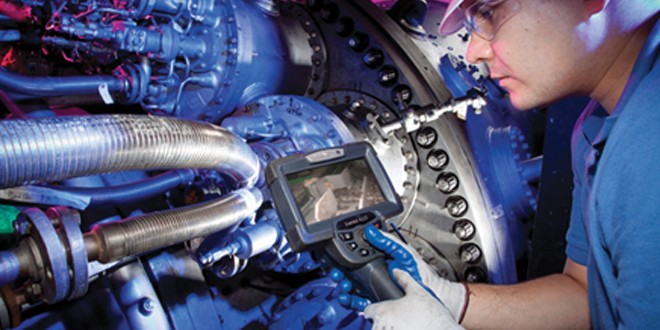NDT Inspection
We are more reliant on high-tech inspection techniques than ever. Take your inspection program to a higher level.
Shortly after beginning the takeoff roll on a scheduled flight from Pensacola, Florida (PNS) to Atlanta (ATL), on July 16, 1996, a McDonnell Douglas MD-88 experienced a catastrophic, uncontained engine failure of the No. 1 engine. Debris from the engine’s front compressor hub penetrated the cabin, killing a woman and her son and injuring two siblings. The accident investigation determined that maintainers had failed to detect a pre-existing crack during a fluorescent penetrant inspection method, and that the maintenance operation lacked protocols to ensure vigilance during such procedures.
While the borescope enabled technicians to see inside a jet engine, it became apparent early in the jet age that once you saw a crack, you were already too late. Dye penetrant inspection along with magnetic particle and fluorescent particle methods were developed, opening up new capabilities for maintenance technicians to detect cracks. Collectively these techniques were categorized as nondestructive testing (NDT).
Still, flawed inspections have resulted in fatal accidents including the Aloha Airlines cabin failure in 1988 and the crash of a DC-10 in Sioux City, Iowa, the following year, underscoring the need for better NDT tools. Aircraft manufacturers, in coordination with aviation regulatory agencies, recognized that these inspections needed to be performed by specialists.
So, when your aircraft requires specific NDT inspections, you not only need to find an authorized provider, you also must find one who can actually return the aircraft to service. This becomes extremely important, especially if a Service Bulletin (SB) or Airworthiness Directive (AD) makes an inspection necessary in a short timeframe. What follows are some tips on how NDT systems work and how to apply them to your aircraft.
See What Cannot Be Seen
In the aviation lexicon, two of the most-despised words are “leaks” and “cracks.” While the former have the decency to let their presence be known, cracks are insidiously stealthy, and by the time you find them you are already too late.
For metallic components, stresses deform the molecular bonds within and create slip bands or tiny creases in the microstructure. Over time, these bands weaken the bond so much that they let go, much like a zipper opening. Crack detection is critical to continued airworthiness, especially for life-limited items. Discovery can ground the aircraft and result in lengthy and costly repair. Other less-sensitive areas may allow some cracking but will require repetitive inspection to ensure crack growth is within acceptable limits.
While penetrant inspections assist in detecting surface cracks, they cannot reveal trouble below. In addition, it has been shown that improperly applied penetrant can actually hide cracks. The most-common and effective method for detecting subsurface cracks is the eddy current method.
This method induces a magnetic field and a probe measures its strength and impedance to detect corrosion, cracks and other defects. The eddy current inspection works on all conductive materials and requires a calibrated test standard to compare the material being tested against. This method also can detect material heat treat and surface condition. It takes extensive training and expertise to ensure that the results are properly diagnosed; in many cases technique for applying the field and probe are critical.
For composite materials, the multi-directional layers of laminate are resistant to cracking, provided that bonding integrity is maintained. Detecting “disbonds” is of keen importance, since the strength of the affected part is determined by the number, type and shape of the defect. One simple method of detecting disbonds is the “coin tap” in which the material is gently struck with a metal object and the inspector listens for a telltale dull thud. Helicopters have been equipped with composite blades for decades, and coin tapping them has shown that method’s efficacy to be extremely subjective, influenced by both the environment and the inspector’s perceptiveness.
Thanks to advances in medical technology, ultrasonic testing (UT) is now often used for detecting bond voids and other defects in composites. This method uses high frequency sound waves to paint a picture of the material in a process much like sonar. The sound wave is bounced off of a surface and by measuring the speed and intensity of the return, the operator can determine if there is an anomaly within. UT also can be used to measure thickness.
New testing technologies emerging to meet the rapidly expanding field of composites include infrared and thermal imaging. Heat transfer through an object can be indicative of disbonds or water entrapment. The thermal camera can detect minute changes in temperature and enhance the display to pinpoint a problem. In addition, microwave and laser-based systems currently under development set up uniform heating of a surface and the optics see how the surface reacts.
A Great Responsibility
The ability to detect potential material failure is a huge benefit to many other industries besides aviation — manufacturing, energy generation and the medical field, among others. Those entrusted with making those discoveries require a high level of training, experience and integrity. The most widely recognized and accepted standard for NDT technicians is the National Aerospace Standard 410, Certification & Qualification of Nondestructive Test Personnel. Based on MIL-STD-410, the training, techniques and certification regime are laid out so all can easily follow. The American Society for Nondestructive Testing also provides guidance and training standards such as the ASNT Standard Practice SNT-TC-1A.
There are four levels of Technician Certification — Trainee, Level I (Limited), Level II (still requires supervision) and Level III (the highest level, also known as the Responsible Level III). Prior to certification, the trainee works under the supervision of a Level II or III certified technician to gain enough experience to pass a test and achieve a Level I rating. Acquiring a Level II certification requires more hours of classroom work and supervised experience. The person with a Level III certification is considered both highly skilled and supervisory, and it is the only level allowed to conduct the required classroom instruction.
In the U.S., the FAA does not recognize the NDT technician as qualified to return an aircraft to service. This puts the maintenance manager or senior technician in a quandary, since returning the aircraft to service requires a positive inspection, but the person who actually performed the work cannot make the logbook entry. While it may be possible to train an A&P to be an NDT tech, it is very difficult to maintain the number of hours and experience required to achieve a Level II or III certification necessary to complete the inspection.
For a maintenance manager, it may be difficult to justify developing and maintaining in-house NDT capability. “It makes sense to have NDT in-house if you are having issues with vendors doing your work,” said Dave Sheehy, director of Aircraft Maintenance, Pro Airways, Plymouth, Massachusetts, who added that having NDT inspection capability within your operation can make good sense, especially if the vendors’ performance is unsatisfactory.
“I used to send main wheels out for overhaul. After having repeat issues with three different vendors, we decided to bring the overhaul and build-up of these wheels in house,” he recalled. “I was previously trained to Level II, so it was a matter of finding a Level III, training for recurrency, and adding the capability to our repair station. This was a long, involved process [more than a year]. Happily, we have had no wheel/tire incidents since.”
For most small to midsize operations, developing an in-house NDT capability is out of reach. The equipment is obtainable, but the expense of the training and required scope hours for the chosen technician trainee is not cost-effective. This means those managing such operations have to find someone who is qualified in NDT and has the tools to perform it. For example, there are companies that specialize in NDT for energy production; they may not be interested in performing a one-hour job on a wheel half. For aviation NDT, your best resource is a qualified FAR Part 145 Repair Station with NDT capability. The technicians there can perform the test and return the aircraft to service.
As more aircraft manufacturers rely on NDT for continued airworthiness of their products, the number of aviation NDT techs receiving more experience on different aircraft makes and models is growing. This expansion benefits the industry, obviously.
“The aviation NDT world is completely different from petroleum, nuclear power and rail inspection,” said Ray Vieselmeyer, the non-destructive testing team leader at Duncan Aviation, Lincoln, Nebraska. “Most of our technicians have a strong academic background coming from Southeast Community College in Milford, Nebraska, which has an excellent NDT training program.”
While technicians from other industries can be trained and capable to perform inspections on aircraft parts, using someone with experience on your specific aircraft model can be the better choice. It all boils down to a matter of trust, since that technician is responsible for the integrity of your aircraft and thus the safety of those on board.
Beyond that, the maintenance manager has to plan ahead and schedule NDT carefully because those services are in high demand. It may be worth adjusting your inspections early just to ensure that you are not left grounded while trying to get an appointment for an inspection. You also want to build up a level of confidence with several NDT providers in case you get hit with an AD or SB with a short compliance time. Good customers are usually bumped to the top of the list in a crisis.
Aviation maintenance has become much more reliant on NDT, and that demands specialized skill and experience of the technician. If you develop you own in-house capability, you’ll need specialized equipment and the designated technician must remain current and qualified, a considerable investment.
Most managers will likely choose outside support for their NDT needs. Those who follow that course must make sure the provider is qualified and experienced with the type of inspection needed for your aircraft. Whichever way you go, don’t hesitate undertaking required NDT inspections since they are uniquely capable of revealing real dangers hidden within. B&CA
by Mike Gamauf – Business & Commercial Aviation

